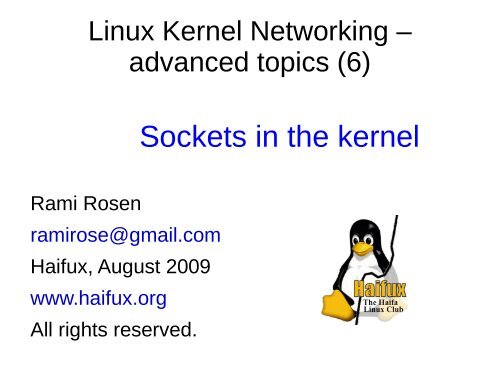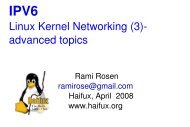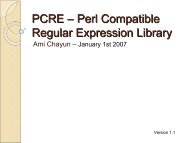Create successful ePaper yourself
Turn your PDF publications into a flip-book with our unique Google optimized e-Paper software.
RAW Sockets●●There are cases when there is no interface to createsockets of a certain protocol (ICMP protocol, NETLINKprotocol) => use Raw sockets.raw socket creation is done thus, for example:– sd = socket(AF_INET, SOCK_RAW, 0);– sd = socket(AF_INET, SOCK_RAW,IPPROTO_UDP);– sd = socket(AF_PACKET, SOCK_RAW, htons(ETH_P_IP));●ETH_P_IP tells to handle all IP packets.– When using AF_INET family, as in the first two cases, thesocket is added to kernel RAW sockets hash table (the hashkey is the protocol number). This is done by raw_hash_sk(),(net/ipv4/raw.c), which is invoked by inet_create(), whencreating the socket.
●●– When using AF_PACKET family, as in the third case, asocket is not added to the kernel RAW sockets hash table.See Appendix F for an example of using packet raw socket.Raw socket creation MUST be done as a superuser.– In case an ordinary user try to create a raw socket,you will get:– “error: socket: Operation not permitted.” (EPERM).– You can set the CAP_NET_RAW capability toenable non root users to create raw sockets:– setcap cap_net_raw=+ep rawserver
Usage of RAW socket: ping●●●You do not specify ports with RAW sockets;RAW sockets do not work with ports.When the kernel receives a raw packet, itdelivers it to all raw sockets.Ping in fact is sending an ICMP packet.– The type of this ICMP packet is ICMP ECHOREQUEST.
Send a pingimplementation(simplified)#define BUFSIZE 1500char sendbuf[BUFSIZE];struct icmp *icmp;int sockfd;struct sockaddr_in target;int datalen=56;target.sin_family = AF_INET;inet_aton("192.168.0.121",&target.sin_addr);icmp = (struct icmp *)sendbuf;icmp->icmp_type = ICMP_ECHO;icmp->icmp_code = 0;icmp->icmp_id= getpid();
memset(icmp->icmp_data, 0xa5, datalen);icmp->icmp_cksum=0;sockfd=socket(AF_INET, SOCK_RAW, IPPROTO_ICMP);res = sendto(sockfd, sendbuf, len, 0, (struct sockaddr*)&target, sizeof(structsockaddr_in));- Missing here is sequence number, checksum computation.- The default number of data bytes to be sent is 56; the ICMPheader is 8 bytes. So we get 64 bytes (or 84 bytes, if we includethe IP header of 20 bytes).
__u8 *buf;Receive a pingimplementation(simplified)char addrbuf[128];struct iovec iov;struct iphdr *iphdr;int sockfd;struct icmphdr *icmphdr;char recvbuf[BUFSIZE];char controlbuf[BUFSIZE];struct msghdr msg;sockfd=socket(AF_INET, SOCK_RAW, IPPROTO_ICMP);
iov.iov_base = recvbuf;iov.iov_len = sizeof(recvbuf);memset(&msg, 0, sizeof(msg));msg.msg_name = addrbuf;msg.msg_namelen = sizeof(addrbuf);msg.msg_iov = &iov;msg.msg_iovlen = 1;msg.msg_control = controlbuf;msg.msg_controllen = sizeof(controlbuf);n = recvmsg(sockfd, &msg, 0);
uf = msg.msg_iov->iov_base;iphdr = (struct iphdr*)buf;icmphdr = (struct icmphdr*)(buf+(iphdr->ihl*4));if (icmphdr->type == ICMP_ECHOREPLY)printf("ICMP_ECHOREPLY\n");if (icmphdr->type == ICMP_DEST_UNREACH)printf("ICMP_DEST_UNREACH\n");
●●The only SOL_RAW option a Raw socket canget is ICMP_FILTER.This can be done thus:#define ICMP_FILTER 1struct icmp_filter {__u32 data;};filt.data = 1
●●●●●Adding this code in the receive Ping applicationabove will prevent Destination UnreachableICMP messages from received in user space byrecvmsg.There are quite a lot more ICMP options; bydefault, we do NOT filter any ICMP messages.Among the other options you can set bysetsockopt are:ICMP_ECHO (echo request)ICMP_ECHOREPLY (echo reply)
●●●ICMP_TIME_EXCEEDEDAnd more (see Appendix D for a full list).Traceroute also uses raw sockets.– Traceroute changes the TTL field in the ip header.– This is done by IP_TTL and control messages incurrent Linux traceroute implementation (DmitryButskoy).– In the original traceroute (by Van Jacobson) it wasdone with the IP_HDRINCL socket option:●(setsockopt(sndsock, IPPROTO_IP, IP_HDRINCL,...)
●●●●●The IP_HDRINCL tells the IP layer not to prepare an IP headerwhen sending a packet.– IP_HDRINCL is also applicable in IPV6.When receiving a packet, the IP header is always included inthe packet.When sending a packet, by specifying the the IP_HDRINCLoption you tell the kernel that the IP header is already includedin the packet, so no need to prepare it in the kernel.– raw_send_hdrinc() in net/ipv4/raw.c– The IP_HDRINCL option is applied only to the SOCK_RAWtype of protocol.See Lawrence Berkeley National Laboratory traceroute:ftp://ftp.ee.lbl.gov/traceroute.tar.gz
●If a raw socket was created with protocol type ofIPPROTO_RAW , this implies enabling IP_HDRINCL:Thus, this call from user space:socket(AF_INET,SOCK_RAW,IPPROTO_RAW)invokes this code in the kernel:if (SOCK_RAW == sock->type) {inet->num = protocol;if (IPPROTO_RAW == protocol)inet->hdrincl = 1;......(From inet_create(), net/ipv4//af_inet.c)
●●●Spoofing attack: setting the IP address ofpackets to be different than the real ones.UDP spoofing is easier since UDP isconnectionless.Following is an example of UDP spoofing withraw sockets and IP_HDRINCL option:– We build an IP header.●We set the protocol field in this ip header toIP_PROTOUDP.– We build a UDP header.– Note : when behind a NAT, this probably will not work
unsigned short in_cksum(unsigned short *addr, int len);int main(int argc, char **argv){struct iphdr ip;struct udphdr udp;int sd;const int on = 1;struct sockaddr_in sin;int res;u_char *packet;packet = (u_char *)malloc(60);
ip.ihl = 0x5;ip.version = 0x4;ip.tos = 0x0;ip.tot_len = 60;ip.id = htons(12830);ip.frag_off = 0x0;ip.ttl = 64;ip.protocol = IPPROTO_UDP;ip.check = 0x0;ip.saddr = inet_addr("192.168.0.199");ip.daddr = inet_addr("76.125.43.103")
memcpy(packet, &ip, sizeof(ip));udp.source = htons(45512);udp.dest = htons(999);udp.len = htons(10);udp.check = 0;memcpy(packet + 20, &udp, sizeof(udp));memcpy(packet + 28,"ab",2);if ((sd = socket(AF_INET, SOCK_RAW, 0)) < 0) {perror("raw socket");exit(1);}
if (setsockopt(sd, IPPROTO_IP, IP_HDRINCL, &on, sizeof(on)) < 0) {}perror("setsockopt");exit(1);memset(&sin, 0, sizeof(sin));sin.sin_family = AF_INET;sin.sin_addr.s_addr = ip.daddr;res=sendto(sd, packet, 60, 0, (struct sockaddr *)&sin, sizeof(struct sockaddr) );if (res
●Note: what will happen if we specify an illegalsource address, like “255.255.255.255”?– The packet will be sent.– If we want to log such packets on the receiver side,(to detect spoofing attempts), we must set thelog_martians kernel tunable thus:●echo "1" > /proc/sys/net/ipv4/conf/all/log_martians– Then we will see in the kernel syslog messages likethis:●●●martian source 82.80.80.193 from 255.255.255.255, ondev eth0Following will be the ethernet header:ll header:
Raw sockets and sniffers●●When you activate tshark (formerly tethereal) orwireshark or tcpdump, you call thepcap_open_live() method of the pcap library.This method creates a raw socket thus:– socket(PF_PACKET, SOCK_RAW, htons(ETH_P_ALL))– pcap_open_live() is implemented in libpcap-0.9.8/pcaplinux.c.PF_PACKET sockets work with the network interface card.
●Note:– When you open tshark thus:●●tshark -i anyThen the socket is opened thus:●socket(PF_PACKET, SOCK_DGRAM,htons(ETH_P_ALL))●●●This is called “cooked mode”SLL. (Socket Link Layer).With SOCK_DGRAM, the kernel is responsible foradding ethernet header (when sending a packet) orremoving ethernet header (when receiving a packet).
●●With SOCK_RAW, the application is responsible for adding anethernet header when sending.Also you will get this message:– “Capturing on Pseudo-device that captures on all interfaces”– tshark: Promiscuous mode not supported on the "any"device
Unix Domain Sockets● AF_UNIX / PF_UNIX / AF_LOCAL /PF_LOCAL.●A way for interprocess communication. (IPC)– the client and server are on the same host.●AF_UNIX sockets can be eitherSOCK_STREAM or SOCK_DGRAM.– And, since kernel 2.6.4, also SOCK_SEQPACKET.●Usage: in rsyslogd(AF_UNIX/SOCK_DGRAM)and udev daemons (AF_LOCAL/SOCK_DGRAM), hald, crond, and a lot more.
●●Unix domain sockets do not support thetransmission of out-of-band data.MSG_OOB is not supported at all in Unixdomain sockets– This applies For all 3 types,SOCK_STREAM,SOCK_DGRAM and SOCK_SEQPACKET.
●Usually uses files in the local filesystem.– Abstract namespaces.●●Why not extend it to use between domains invirtualization which have access to shared filesystem ?With rsyslogd, the path is under /dev:– ls -al /dev/log●●srw-rw-rw- 1 root root 0 01-07-09 13:17 /dev/logNotice the 's' in the beginning => for socket.– ls -F /dev/log●●/dev/log=(with ls, -F is for appending indicator to entries)
int s;int res;Unix Domain Socket serverExamplestruct sockaddr_un name;memset(&name,0,sizeof (name));name.sun_family = AF_LOCAL;strcpy(name.sun_path,"/work/test_unix");s = socket(AF_UNIX, SOCK_STREAM,0);if (s
●●●●Calling bind() in the example above will create afile named /work/test_unixls -al /work/test_unix– srwxr-xr-x– Notice the “s” for socket.Notice that with DGRAM Unix domain sockets, calling sednto()without calling bind() before, will not call autobind() asopposed to what happens in udp under the same scenario.In this case, the receiver cannot reply (because it does notknow to who).
●●●●lsof -U : shows Unix domain socketsAlso: netstat --unix –all– Tip: use netstat -ax for short.●[ACC] in the third column means that the socket isunconnected and waiting for connection.(SO_ACCECPTON).And also:– cat /proc/net/protocols | grep UNIX– cat /proc/net/unixstruct sockaddr_un (/usr/include/linux/un.h)
●●●The pathname for a Unix domain socket shouldbe an absolute pathname.For abstract namespaces:– address.sun_path[0] = 0The last column of netstat --unix --all is thepath.– In case of abstract namespace, it will begin with @:– netstat --unix --all | grep udevd– unix 2 [ ] DGRAM 602@/org/kernel/udev/udevd
●Control messages in Unix domain sockets:– SCM_RIGHTS - You can pass an open filedescriptor from one process to another using Unixdomain socket and control messages (ancillarydata).– SCM_CREDENTIALS- for passing processcredentials (uid and gid).●You need to set the SO_PASSCRED socket option withsetsockopt() on the receiving side.●SCM stands for : Socket Control Message ,and notSoftware configuration management :-)
●These credentials are passed via a cred structin a control message:kernel: in include/linux/socket.h:struct ucred {__u32 pid; /* process ID of the sending process */__u32 uid; /* user ID of the sending process */__u32 gid; /* group ID of the sending process */};For user space apps, it is in /usr/include/bits/socket.h
Unix domain client exampleconst char* const socket_name = "/tmp/server";int socket_fd;int res;struct sockaddr_un remote;socket_fd = socket(PF_LOCAL, SOCK_STREAM, 0);memset(&remote, 0, sizeof(remote));remote.sun_family = AF_LOCAL;strcpy(remote.sun_path, socket_name);res = connect(socket_fd, (struct sockaddr*)&remote, SUN_LEN(&remote));if (res
●If we will try to call send() in a stream-orientedsocket after the stream-oriented server wasclosed, we will get EPIPE error:– send: Broken pipe●●●The kernel also sends the user space aSIGPIPE signal in this case.In case the flags parameter in send() isMSG_NOSIGNAL, the kernel does NOT send aSIGPIPE signal.In BSD, you can avoid signals by setsockopt()with SO_NOSIGPIPE (SOL_SOCKET option).
●●In IPV4, the only signal used is SIGURG forOOB in tcp.In case of datagram-oriented sockets, SIGPIPEis not sent; we just get connection refused error.
●●If, in the above example, we tried to create adgram client instead of stream client, thus;– socket_fd = socket(PF_LOCAL, SOCK_DGRAM, 0);– We would get:– connect: Protocol wrong type for socket (EPROTOTYPE)●see: unix_find_other()The socketpair() system call:●Creates a pair of connected sockets.●On Linux, the only supported domain for this call isAF_UNIX (or synonymously, AF_LOCAL).
Netlink sockets●●Netlink sockets: a message mechanism fromuser-space to kernel and also between kernelingredients.Used widely in the kernel; mostly in networking,but also in other subsystems.– There are other mechanism for communication fromuser space to kernel:●●ioctls (drivers)/proc or /sys entries (VFS)– And there are of course signals from kernel to userspace (like SIGIO, and more).
●●Creating netlink sockets is done (in the kernel) bynetlink_kernel_create().For example, in net/core/rtnetlink.c:static int rtnetlink_net_init(struct net *net){struct sock *sk;sk = netlink_kernel_create(net, NETLINK_ROUTE,RTNLGRP_MAX, rtnetlink_rcv, &rtnl_mutex,THIS_MODULE);
●With generic netlink sockets, this is done usingthe NETLINK_GENERIC protocol thus:● netlink_kernel_create(&init_net, NETLINK_GENERIC, 0,genl_rcv, &genl_mutex, THIS_MODULE);– See net/netlink/genetlink.c
●●The second parameter, NETLINK_ROUTE, is theprotocol. (kernel 2.6.30).There are currently 19 netlink protocols in thekernel:NETLINK_ROUTE NETLINK_UNUSED NETLINK_USERSOCKNETLINK_FIREWALLNETLINK_XFRMNETLINK_INET_DIAG NETLINK_NFLOGNETLINK_SELINUX NETLINK_ISCSINETLINK_AUDIT NETLINK_FIB_LOOKUP NETLINK_CONNECTORNETLINK_NETFILTER NETLINK_IP6_FW NETLINK_DNRTMSGNETLINK_KOBJECT_UEVENT NETLINK_GENERIC NETLINK_SCSITRANSPORTNETLINK_ECRYPTFS(see include/linux/netlink.h).
●●●●The fourth parameter, rtnetlink_rcv, is the handlerfor netlink packets.rtnetlink_rcv() gets a packet (sk_buff) as itsparameter.NETLINK_ROUTE messages are not confined to therouting subsystem; they include also other types ofmessages (for example, neighboring)NETLINK_ROUTE messages can be divided intofamilies. Most of these families has three types ofmessages. (New, Del and Get).
●For example:●RTM_NEWROUTE – create a new route.– Handled by inet_rtm_newroute().●●●RTM_DELROUTE - delete a route.– Handled by inet_rtm_delroute().RTM_GETROUTE – retrieve information about aroute.– Handled by inet_dump_fib().All three methods are in net/ipv4/fib_frontend.c.
●Another family of METLINK_ROUTE is the NEIGH family:– RTM_NEWNEIGH– RTM_DELNEIGH– RTM_GETNEIGH
●●●How do these messages reach these handlers?Registration is done by calling rtnl_register()in ip_fib_init():– rtnl_register(PF_INET, RTM_NEWROUTE,inet_rtm_newroute, NULL);– rtnl_register(PF_INET, RTM_DELROUTE,inet_rtm_delroute, NULL);– rtnl_register(PF_INET, RTM_GETROUTE, NULL,inet_dump_fib);
●●●●●●IPROUTE2 package is based on rtnetlink.(IPROUTE2 is “ip” with subcommands, forexample: ip route show to show the routingtables)IPROUTE2 uses the libnetlink library.See libnetlink.h (in the IPROUTE2 library)rtnl_open() to open a socket in user space.rtnl_send() to send a message to the kernel.
●rtnl_open() calls the socket() system call tocreate an rtnetlink socket:– socket(AF_NETLINK, SOCK_RAW, protocol);●●rtnl_listen() starts receiving messages by calling the recvmsg()system call.The AF_NETLINK protocol is implemented innet/netlink/af_netlink.c.– AF_ROUTE is a synonym of AF_NETLINK (due to BSD)– #define AF_ROUTE AF_NETLINK (include/linux/socket.h)– The kernel holds an array called nl_table; it has upto 32 elements. (MAX_LINKS).– Each element in this table corresponds to aprotocol (in fact, the protocol is the index)
Example#include "libnetlink.h"int accept_msg(const struct sockaddr_nl *who, struct nlmsghdr *n, void *arg) {}if (n->nlmsg_type == RTM_NEWROUTE)printf("got RTM_NEWROUTE message \n");int main() {}int res;struct rtnl_handle rth;unsigned int groups = ~RTMGRP_TC | RTNLGRP_IPV4_ROUTE;if (rtnl_open(&rth,groups) < 0) {printf("rtnl_open() failed in %s %s\n",__FUNCTION__,__FILE__);return -1;
if (rtnl_listen(&rth,accept_msg, stdout)
Generic Netlink●●●●The iw tools (wireless user space management)use the Generic Netlink API.This API is based on Netlink sockets.You register handlers in nl80211_init()net/wireless/nl80211.c
●●●For example, for wireless interfaces we havethese messages and handlers:NL80211_CMD_GET_INTERFACEHandled by nl80211_dump_interface()●NL80211_CMD_SET_INTERFACE– Handled by nl80211_set_interface()●NL80211_CMD_NEW_INTERFACE– Handled by nl80211_new_interface()●●NL80211_CMD_DEL_INTERFACEHandled by nl80211_del_interface()
●In the wireless subsystem there are currently35 messages, each with its own handler.– See appendix A.
●You can use the NETLINK_FIREWALL protocolfor a netlink socket to catch packets in userspace with the help of an iptables kernelmodule named ip_queue.ko.● iptables -A OUTPUT -p UDP --dport 9999 -jNFQUEUE --queue-num 0●●The user space application useslibnetfilter_queue-0.0.17 API (which replacedthe libipq lib).Netlink sockets usage: xorp, (routing daemons:http://www.xorp.org/) , iproute2, iw.
SCTP●General:– Combines features of TCP and UDP.– Reliable (like TCP).– RFC 4960 (obsoletes RFC 2960).– Target: VoIP, telecommunications.●People:– Randall Stewart (Cisco): co inventor, FreeBSD.– Peter Lei (Cisco)– Michael Tuxen (MacOS).
●●●Linux Kernel SCTP Maintainers:●●Vlad Yasevich (HP)Sridhar Samudrala (IBM).SCTP support in the Linux kernel tree is fromversions 2.5.36 and following.Location in the kernel tree: net/sctp.
SCTP●There are two types of SCTP sockets:– One to one socket●●socket(AF_INET, SOCK_STREAM, IPPROTO_SCTP).Much like TCP connection.– One to many socket●●socket(AF_INET, SOCK_STREAM, IPPROTO_SCTP).Much like UDP server with many clients.
●You need to have lksctp-tools to use SCTP inuserspace applications.●http://lksctp.sourceforge.net– In fedora,●lksctp-tools rpm.●lksctp-tools-devel rpm. (for /usr/include/netinet/sctp.h)
Future lectures●Netfilter kernel implementation:– NAT and connection tracking; dnat, snat.– MASQUERADING.– Filter and mangle tables.– Netfilter verdicts.– The new generation: nftables●●●Network namespaces (Containers / OpenVZ).DCCPVirtio
●●●●●●IPVS/LVS (Linux Virtual Server).Bluetooth, RFCOMM.Multiqueues.LRO (Large Receive Offload)Multicasting.TCP protocol.
Appendix A : wireless messagesNL80211_CMD_GET_WIPHY, NL80211_CMD_SET_WIPHY,NL80211_CMD_GET_INTERFACE,NL80211_CMD_SET_INTERFACE,NL80211_CMD_NEW_INTERFACE,NL80211_CMD_DEL_INTERFACE,NL80211_CMD_GET_KEY,NL80211_CMD_SET_KEY,NL80211_CMD_NEW_KEY,NL80211_CMD_DEL_KEY,NL80211_CMD_SET_BEACON, NL80211_CMD_NEW_BEACON, NL80211_CMD_DEL_BEACON,NL80211_CMD_GET_STATION, NL80211_CMD_SET_STATION, NL80211_CMD_NEW_STATION, NL80211_CMD_DEL_STATION,NL80211_CMD_GET_MPATH, NL80211_CMD_SET_MPATH, NL80211_CMD_NEW_MPATH, NL80211_CMD_DEL_MPATH,NL80211_CMD_SET_BSS, NL80211_CMD_GET_REG,NL80211_CMD_SET_REG, NL80211_CMD_REQ_SET_REG,NL80211_CMD_GET_MESH_PARAMS,NL80211_CMD_SET_MESH_PARAMS,NL80211_CMD_TRIGGER_SCAN, NL80211_CMD_GET_SCAN,NL80211_CMD_AUTHENTICATE,NL80211_CMD_ASSOCIATE, NL80211_CMD_DEAUTHENTICATE,NL80211_CMD_DISASSOCIATE,NL80211_CMD_JOIN_IBSS,NL80211_CMD_LEAVE_IBSS,
Appendix B : Socket options●Socket options by protocol:IP protocol (SOL_IP) 19 socket options:IP_TOS IP_TTLIP_HDRINCLIP_OPTIONSIP_ROUTER_ALERT IP_RECVOPTSIP_RETOPTSIP_PKTOPTIONSIP_RECVERRIP_RECVTOSIP_FREEBINDIP_XFRM_POLICYIP_PKTINFOIP_MTU_DISCOVERIP_RECVTTLIP_MTUIP_IPSEC_POLICYIP_PASSSECIP_TRANSPARENTNote: For BSD compatibility there is IP_RECVRETOPTS (which is identical toIP_RETOPTS).
●AF_UNIX:– SO_PASSCRED for AF_UNIX sockets.●– Note:For historical reasons these socket options are specified with aSOL_SOCKET type even though they are PF_UNIX specific.UDP:– UDP_CORK (IPPROTO_UDP level).●RAW:– ICMP_FILTER●TCP:– TCP_CORK– TCP_DEFER_ACCEPT– TCP_INFO– TCP_KEEPCNT
– TCP_KEEPIDLE– TCP_KEEPINTVL– TCP_LINGER2– TCP_MAXSEG– TCP_NODELAY– TCP_QUICKACK– TCP_SYNCNT– TCP_WINDOW_CLAMP●AF_PACKET– PACKET_ADD_MEMBERSHIP– PACKET_DROP_MEMBERSHIP
Socket options for socket level:SO_DEBUGSO_REUSEADDRSO_TYPESO_ERRORSO_DONTROUTESO_BROADCASTSO_SNDBUFSO_RCVBUFSO_SNDBUFFORCESO_RCVBUFFORCESO_KEEPALIVESO_OOBINLINE
SO_NO_CHECKSO_PRIORITYSO_LINGERSO_BSDCOMPAT
Appendix C: tcp client#include #include #include #include #include #include #include #include #include #include int main(){
}tcp client - contd.struct sockaddr_in sa;int sd = socket(PF_INET, SOCK_STREAM, 0);if (sd
tcp client - contd.●●If on the other side (192.168.0.121 in this example) there is noTCP server listening on this port (853) you will get this error forthe socket() system call:– connect: Connection refused.You can send data on this socket by adding, for example:const char *message = "mymessage";int length;length = strlen(message)+1;res = write(sd, message, length);●write() is the same as send(), but with no flags.
Appendix D : ICMP options●These are ICMP options you can set withsetsockopt on RAW ICMP socket:(see /usr/include/netinet/ip_icmp.h)ICMP_ECHOREPLYICMP_DEST_UNREACHICMP_SOURCE_QUENCHICMP_REDIRECTICMP_ECHOICMP_TIME_EXCEEDEDICMP_PARAMETERPROBICMP_TIMESTAMP
ICMP_TIMESTAMPREPLYICMP_INFO_REQUESTICMP_INFO_REPLYICMP_ADDRESSICMP_ADDRESSREPLY
APPENDIX E: flags for send/receiveMSG_OOBMSG_PEEKMSG_DONTROUTEMSG_TRYHARD - Synonym for MSG_DONTROUTE for DECnetMSG_CTRUNCMSG_PROBE - Do not send. Only probe path f.e. for MTUMSG_TRUNCMSG_DONTWAIT - Nonblocking ioMSG_EOR - End of recordMSG_WAITALL - Wait for a full request
MSG_FINMSG_SYNMSG_CONFIRM - Confirm path validityMSG_RSTMSG_ERRQUEUE - Fetch message from error queueMSG_NOSIGNAL - Do not generate SIGPIPEMSG_MORE0x8000 - Sender will send more.
Example: set and get an option●This simple example demonstrates how to set and get an IP layer option:#include #include #include #include #include int main(){int s;int opt;int res;int one = 1;int size = sizeof(opt);
s = socket(AF_INET, SOCK_DGRAM, 0);if (s
Example: record route option●This example shows how to send a record routeoption.#define NROUTES 9int main(){int s;int optlen=0;struct sockaddr_in target;int res;
char rspace[3+4*NROUTES+1];char buf[10];target.sin_family = AF_INET;target.sin_port=htons(999);inet_aton("194.90.1.5",&target.sin_addr);strcpy(buf,"message 1:");s = socket(AF_INET, SOCK_DGRAM, 0);if (s
space[1+IPOPT_OFFSET] = IPOPT_MINOFF;optlen=40;if (setsockopt(s, IPPROTO_IP, IP_OPTIONS, rspace,sizeof(rspace))
Appendix F: using packet rawsocketint main(){int s;int n;char buffer[2048];unsigned char *iphdr;unsigned char *ethhdr;s = socket(PF_PACKET, SOCK_RAW, htons(ETH_P_IP));while (1){printf("*******\n");n = recvfrom(s, buffer, 2048, 0, NULL, NULL);printf("n bytes read\n")
ethhdr = buffer;printf("source MAC address = %02x:%02x:%02x:%02x:%02x:%02x\n",ethhdr[0],ethhdr[1],ethhdr[2],ethhdr[3],ethhdr[4],ethhdr[5]);}}
Tips●●●●●●To find out socket used by a process:ls -l /proc/[pid]/fd|grep socket|cut -d: -f3|sed 's/\[//;s/\]//'The number returned is the inode number of the socket.Information about these sockets can be obtained from– netstat -aeAfter starting a process which creates a socket, you can seethat the inode cache was incremented by one by:more /proc/slabinfo | grep sock● sock_inode_cache 476 485 768 5 1 : tunables 0 00 : slabdata 97 97 0●The first number, 476, is the number of active objects.
END●● Thank you!●– ramirose@gmail.com
















